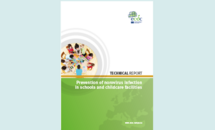Prevention of norovirus infection in schools and childcare facilities
Norovirus is one of the most common causes of childhood gastroenteritis and has epidemiological characteristics that promote a high rate of infectivity and transmission. The report aims to contribute to identifying the key facts that can support message development for the implementation of health communication activities in childcare settings. This report was subject to a public consultation from 12 July to 31 August 2012 and was revised to take into account relevant comments that arose from that consultation.
Executive Summary
Norovirus, which has epidemiological characteristics that promote a high rate of infectivity and transmission, remains one of the most common causes of childhood gastroenteritis. A new technical report from ECDC provides guidance on steps that can be taken to better prevent and control outbreaks.
The Prevention of Norovirus Infection in Schools and Childcare Facilities report offers guidance to EU Member States regarding the efficacy of different ways to manage the spread of the virus. It also reviews findings related to the prevention and control of outbreaks of gastroenteritis in schools and childcare facilities.
Much of the guidance has been synthesised from numerous other international guideline documents, which have been formed by expert consensus. There is limited primary research on the efficacy of interventions for the prevention and control of norovirus.
Primary prevention measures include effective hand hygiene, frequent cleaning of childcare environments, especially toilet facilities, and adherence to robust food hygiene standards. The effectiveness of each measure is discussed more fully in the report.
This technical report was open to public consultation between 12 July and 31 August 2012. The responses to the consultation were taken into account and the report revised accordingly.
Download

Read more on the ECDC website
Communication toolkit
Communication toolkit on gastrointestinal diseases: How to support infection prevention in schools
This toolkit aims to support infection prevention in schools, with a focus on gastrointestinal diseases, by assisting EU/EEA countries in their communication initiatives for disease prevention in school settings.
Surveillance and monitoring
Prevention of norovirus infection in schools and childcare facilities - Public Consultation
This technical report synthesises current international guideline recommendations and reviews findings related to the prevention and control of gastroenteritis outbreaks in schools and child care facilities.







